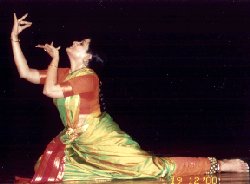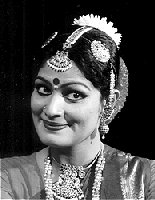
|
 |

|
 |
|
ENGAGING THE METROPOLIS: NEW CHALLENGES TO BHARATANATYAM by Geeta Chandran (Natya Kala Conference 2000) Mar 2001  How can a performing artist today ensure that interest in a classical dance form is retained in an audience that is largely uninitiated and probably unprepared for the pristine classical presentation? Today, the problems that face dancers are many: cosmopolitan audiences are interested in star names, audiences are generally interested in hyped-up events, audiences are interested in something new or something packaged exotically, etc. What have been some of the specific initiatives I have undertaken to engage audiences in northern metropolises and thereby develop a larger audience baseline for my performances? I. One of the challenges for me in Delhi has been to keep the intellectual dialogue alive through which audiences can be engaged. Thus it is that I have worked on contemporary poems in English using traditional Bharatanatyam vocabulary so that the outreach is optimized. I remember during my college days my friends used to comment that the "Tillana" was good and the costume gorgeous, but that they could understand nothing beyond that. I think I have successfully built a committed audience for my dance through engaging my audiences intellectually and especially through the crosscutting themes of environment and gender equity and space for personhood for women. II. The northern audiences, familiar with the Kathak traditions of "padhant" where the dancers use vachika to communicate with the audience, often find themselves stonewalled by Bharatanatyam. After much audience research and correlating our dance style to their needs, my performances today are punctuated with demonstrations based on research linking iconography, paintings, sculpture, in order to educate the audiences. III. The other work has been the logical conclusion of living in the North where language remains a continuing barrier to complete communication. While the work of the Bhakti poets is popular in Bharatanatyam parlance, I have stretched the frontier further by integrating Hindustani music traditions like Dhrupad and Haveli sangeet. In the north usually music and dance are presented together in several cultural festivals. By including local vernacular music traditions in my performances, the audience for Bharatanatyam in the traditional bastions of "Hindustani" music has yielded space for appreciating the southern dance form. IV. Yet another dimension of my work in Bharatanatyam has been in the field of sangeetha-bhavangika abhinayam, which was taught to me by my first guru Smt. Swarna Saraswathy. In this tradition of abhinaya every sangathi in the music score is translated in the spine of the dancer and colours the dance with indelible musicality. The challenge is always to catch the initial attention of the audience. Once that is achieved, they remain with you through the vicissitudes of your art and form wonderful rasikas. The lec-dem at Krishna Gana Sabha presented the following aspects: 1. Contemporary poetry 2. Haveli sangeet 3. Sangeeta-bhavangika-abhinaya 4. Demonstration of Devi iconography and dance.  Geeta Chandran was trained by a galaxy of eminent gurus. Her first guru Swarna Saraswathy hailed from a traditional parampara of dancers. is the founder President of Natya Vriksha where she teaches Bharatanatyam. She is also an accomplished vocalist and is well known for her work in television, video and film, theatre, choreography, dance education and dance - issue journalism. She was one of the youngest dancers invited by the Sangeet Natak Akademi to participate in the prestigious Sangeet Samaroh to mark 50 years of India's independence. |